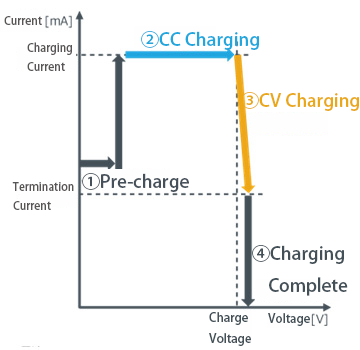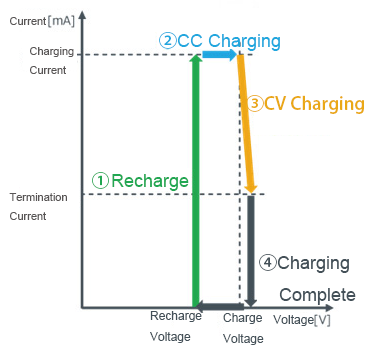Charging Method
- A charge control IC is an IC that charges rechargeable batteries and does the following:
- ・Controls the charge current, voltage, and power
・Protects against abnormal conditions
・Monitors various parameters
The charge control IC monitors the voltage, current and temperature and performs optimized charge control tailored to the rechargeable battery with an eye towards safety and to extend battery life.
Main Charge Methods for Rechargeable Batteries
- Constant Current Charging(CC:Constant Current)
- Constant current charging is a method of continuously charging a rechargeable battery at a constant current to prevent overcurrent charge conditions.
(There is also a method of charging at a low constant current or varying the current in stages to prevent overvoltage charge) - Constant Voltage Charging(CV:Constant Voltage)
- Constant voltage charging is a method of charging at a constant voltage to prevent overcharging.
The charging current is initially high then gradually decreases.
(There is also a method where the voltage is initially low then gradually increased to prevent excessive temperature rise in the rechargeable battery) - Constant Power Charging(CP:Constant Power)
- A constant charging method characterized by high initial current when the voltage is low, then decreasing current as the voltage gradually increases.
- Constant Current Constant Voltage Charging(CCCV:Constant Current , Constant Voltage)
- CCCV charging is a typical method of charging rechargeable batteries such as li-ion.
Operation switches between CC charging, which charges with a constant current, and CV that charges at a constant voltage, depending on the voltage of the rechargeable battery.
This is one of the methods used in ROHM charge control ICs.
Example of ROHM’s Charging IC Profile

| Charging Status | Charge Control Method | Battery Status | |
|---|---|---|---|
| ① Pre-charge | ●Charging start →Charge with a small current |
●Battery capacity and voltage are low ●The battery resistance component is large, preventing charging with high current |
 |
| ② CC Charging | ●Constant current (CC) charging at the set current value | ●The resistance component decreases as battery voltage increases, allowing the battery to be charged with higher current |  |
| ③ CV Charging | ●Switch to constant voltage (CV) charging at the set voltage value | ●The specified charge voltage has been reached, but the battery voltage is low due to internal impedance. The charging current decreases as the internal battery voltage increases. |
 |
| ④ Charging Completed | ●When the charge current reaches the set termination value, charging is continued for a fixed interval then stopped. | ●Charging completed with minimal effect on battery voltage due to internal impedance →Fully charged |
 |
Example of ROHM’s Charging IC Profile (with Charging Cord Plugged In)

| Charging Status | Charge Control Method | Battery Status | |
|---|---|---|---|
| ① Recharge | ●Recharge start →Charging started when the battery is reduced to the preset recharge voltage value |
●Battery capacity is reduced through use and the voltage drops |  |
| ② CC Charging | ●Constant current (CC) charging at the preset current value | ●Battery voltage increases, the resistance component decreases, allowing the battery to be charged with higher current |  |
| ③ CV Charging | ●Switch to constant voltage (CV) charging at the preset voltage value | ● The preset charge voltage has been reached but the battery voltage is still low |  |
| ④ Charging Completed | ●Charging ends when the battery voltage rises and the preset termination current value is reached | ●Fully Charged |  |
The voltage of rechargeable batteries increases as they are charged. However, supplying too much voltage can cause damage.
CCCV charging promotes longer battery life and improved safety by switching between CC charging that prevents overcurrent charging and CV charging to prevent overvoltage, according to the battery status.
- Constant Power Constant Voltage Charging(CPCV:Constant Power , Constant Voltage)
- In the initial stage of charging when the battery voltage is low, charging is performed at a constant power, and when the battery is close to full charge, operation switches to CV charging to prevent overvoltage conditions.
Unlike CC charging, CP charging can be performed at a higher current to match the power, increasing charging efficiency. - Pulse Charging
- A charging method that prevents sulfation by applying minute pulses (frequency) to the charging current.
When using lead-acid batteries, a part of the electrolyte called ‘sulfation’ becomes crystallized lead that does not conduct electricity and accumulates on the negative electrode side.
If this occurs, efficiency is reduced due to a decrease in storage capacity and an increase in internal resistance.
In such cases, pulse charging is effective as it can successfully break up these crystalline solids. - Trickle Charging
- A method of continuously charging the battery with a small current. Its name derives from the trickle of water.
Although the charging time is longer, the advantage is that the battery is not affected even if a small current continues to flow in a fully charged state.
This makes them Ideal for recharging lead-acid batteries, which have a high natural discharge rate, as well as batteries for emergency standby equipment that are not in constant use.
There are a variety of methods and combination of methods for charging rechargeable batteries, including those listed above.
The role of the charge control IC is to control the charge current, voltage, and power settings to achieve optimal charging according to battery characteristics.




